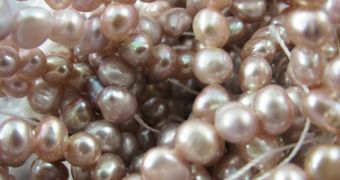Pearls are the only gemstones of organic origin and the second most valuable after diamonds. Given this, it's no wonder that pearl fishing, even if dangerous and exhausting, is an occupation widely spread on tropical coasts, from the shores of the Indian Ocean to the Gulf of Mexico and Panama.
The "producers" of pearls are some of the oyster species, like Pteria margaritifera. The origin of the so much desired gem is found in a foreign body, a sand grain or a minute parasite tapeworm, that sneaks in by chance between the body and the mantle of the mollusk, when the valves are opened to allow the freshwater current to bring food and oxygen to the animal. In order to defend itself, the bivalve gradually secretes around the unwanted guest numerous layers of concentric covers, like the layers of an onion, closing it forever in a mother-of-pearl prison.
The pearl fishing traditionally involved free diving to depths of 20-25 m (66-83 ft). The Japanese diver women called Ama (after the goddess of the sea) were internationally famous. Their occupation was transmitted amongst generations from mothers to daughters. Wearing just short pants and a white shirt (colors known not to attract the sharks), they were able, after the age of 17-18, to remain for 2-3 minutes at depths of 15-30 m (50-100 ft) without any scuba equipment! The training started around the age of 12-13 years. In fact, Ama dove for food like seaweed, shellfish, lobsters, octopus, sea urchins and oysters, which can produce pearls. Most of Ama are women because they naturally have more body fat, which ensures a better isolation in colder water.
Until the end of the 19th century, the world's markets received only natural pearls fished by local people. This did not satisfy the demand and, one century ago, the Japanese invented pearl farming. The pioneer of this achievement was Kokichi Mikimoto, a bivalve and snail seller. After observing how the bivalves make a pearl, he imagined a simple and ingenious procedure: the sowing of the Japanese pearl oyster (Pinctada martensii).
In the case of pearl farming, a fragment from the mantle of a pearl oyster is grafted on another individual of the same species. The cells of the inner epithelium degenerate, but the conjunctive tissue joins that of the host. The external epithelium proliferates forming a sac. If the sac does not get a support, it deforms itself. To avoid this, a foreign body is introduced as a support, maintaining its rounded shape.
After checking for various materials, from silver grains to plastic balls, the best results were achieved with fragments from the shell of an American bivalve from the Mississippi. The changing of the salt levels in culture waters was found to modify the color of the pearls, thus farming led to shapes and hues that bypass natural patterns.
Since 1896 to 1954, when he died aged 96, Mikimoto fought to extend pearl farming, perfecting the culture methods and turning this occupation into a profitable one. Several times he lost cases all his cultures, but he persevered and, by 1930, great European jewelers were asking for his pearls. In a 1939 New York exhibition, Mikimoto presented a reproduction of the Liberty Bell made of 12,250 pearls and 306 diamonds, evaluated at $1,000,000 back then. In the year of its death, his farm at Toba Bay had 1.5 billion pearl oysters, with an annual production of 1 million pearls.

 14 DAY TRIAL //
14 DAY TRIAL //